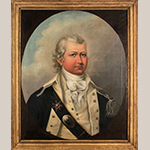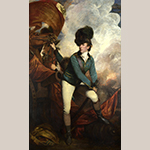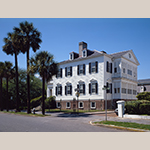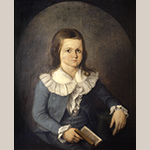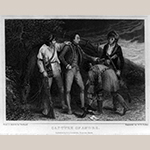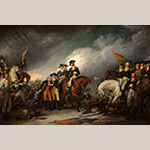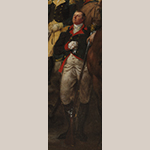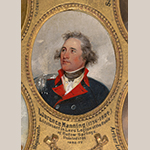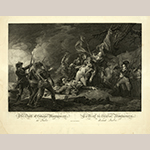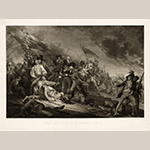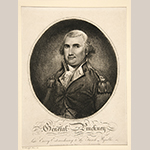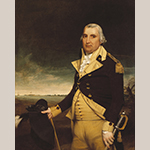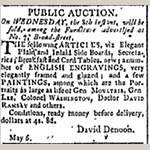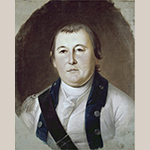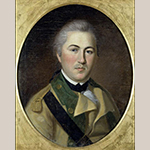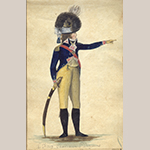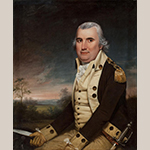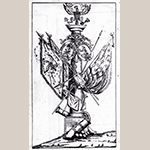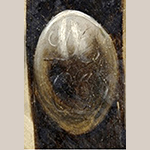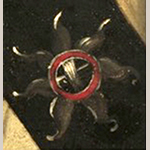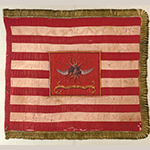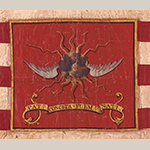The exceptional portrait of famed Revolutionary War cavalry commander Brigadier General William Washington (1752–1810) illustrated in Figure 1 was last documented in a 1799 newspaper advertisement before slipping unrecognized into the mists of time. The painting, attributed to the artist Thomas Coram (1756–1811), recently came to light in a private East Tennessee collection. Depicted in the uniform of the Charleston Light Dragoons, a South Carolina militia unit that William Washington commanded from 1792 until 1798, this oil-on-canvas painting reveals a fascinating two-hundred-year-old tale of heroism, commemoration, and ambition.
The deep historical significance of Washington’s portrait is found not only through its famed sitter, but also through the context in which Coram produced the painting and the individuals with whom the artist interacted in the closing years of the eighteenth century. Those men included, directly and indirectly, luminaries such as the American painter John Trumbull (1756–1843), Charleston-born engraver James Akin (1773–1846), English artist Thomas Stothard (1755–1834), and London museum director and publisher Robert Bowyer (1758–1834). Of particular interest is the role this painting may have played in the drama surrounding America’s nascent attempts to promote South Carolina Revolutionary-era heroes through art.
Brigadier General William Washington
Born in Virginia, William Washington began his military career at the outbreak of the American Revolution in 1775 as a captain with the colony’s Stafford County Minutemen.[1] His militia unit soon formed a company of the 3rd Virginia Regiment, and as winter approached at the end of 1776 posted to New York with the Continental Army. Shortly thereafter, on 26 December, he was wounded while leading a charge on foot to capture a Hessian artillery battery at the Battle of Trenton. That heroic action and his command abilities set the stage for his wartime career, earned him a coveted promotion to the cavalry—first as a major in the 4th Continental Light Dragoons and, in 1778, to lieutenant colonel in command of the 3rd Continental Light Dragoons.[2] The following November, his second cousin, General George Washington ordered him to take his troops to South Carolina. He would spend the rest of his life in his adopted state.[3]
Among William Washington’s noted Revolutionary engagements was the Battle of Cowpens, South Carolina in January 1781. There, as the 29-year-old commander of the 3rd Continental Light Dragoons, he led repeated charges against the combined infantry and cavalry force of the despised British cavalry leader Lt. Col. Banastre Tarleton (Figure 2). Washington’s actions, together with those of General Nathaniel Greene and Lt. Col. John Eager Howard, not only won the battle but were the turning point in the larger southern campaign and forced the British to begin a retreat toward the coast. The three officers’ exploits earned Congressional medals for valor and vaulted their reputations to national prominence.
South Carolina’s beloved Federal-era historian Dr. David Ramsay (1749–1815) published the widely acclaimed History of the Revolution of South Carolina in 1785. There he reported the vital details of the Battle of Cowpens, and placed their significance in larger perspective:
Tarleton, on the 17th of January 1781, engaged [General Daniel] Morgan, with the expectation of driving him out of the country… . In this crisis of the battle, Washington made a successful charge upon Lieutenant-Colonel Tarleton who was cutting down the militia. Lieutenant-Colonel Howard, almost at the same moment, rallied the Continental troops, and charged with fixed bayonets. The example was instantly followed by the militia… . Nothing could exceed the astonishment and confusion of the British occasioned by these unexpected charges… . In this moment of confusion Howard called to them to “lay down their arms,” and promised them good quarters [sic]. Upward of five hundred accepted the offer, and surrendered. Previous to this general surrender, three hundred of the corps, commanded by Tarleton, had been killed, wounded or taken. Eight hundred stand of arms, two field-pieces and thirty five baggage-wagons also fell into the hands of the Americans… . The glory and importance of this action resounded from one end of the continent to the other. It re-animated the desponding friends of America, and seemed to be like a resurrection from the dead to the southern States.[4]
Ramsay noted that on 9 March 1781, less than two months after the engagement at the Cowpens, Congress voted to honor the three officers who had led the offensive by passing a resolution stating:
That the thanks of the United States in Congress assembled, be given to Brigadier-general Morgan and the officers and men under his command, for their fortitude and good conduct displayed in the action at the Cowpens, in the state of South Carolina, on the seventeenth day of January last: “That a medal of gold be presented to Brigadier-General Morgan, and a medal of silver to Lieutenant-Colonel Washington, of the cavalry, and one of silver to Lieutenant-Colonel Howard, of the infantry of the United States, severally, with emblems and mottoes descriptive of the conduct of those officers respectively on that memorable day.”[5]
William Washington’s service at the Battle of Eutaw Springs in September 1781 was no less noteworthy, though of greater personal consequence, for he suffered serious wounds when leading a cavalry charge and fell captive to the British. Kept on a lenient parole within occupied Charleston until the British evacuation in December 1782, the famous wounded Colonel was nursed back to health by Jane Elliott, a beautiful young heiress from one of the region’s most substantial plantation families. They had met at her father’s house at the outset of Washington’s service in South Carolina, when she had presented him a red damask silk regimental standard, hastily pressed into service from a piece of upholstery. Through his subsequent military exploits, Jane Elliott’s standard became known in the American South as “Tarleton’s Terror.” William and Jane Washington were married in April of 1782.[6]
After the Revolution, Washington was given command of the 7th Brigade of South Carolina Militia, which included the Charleston Light Dragoons. He held that position until the outbreak of hostilities in the Quasi-War with France in 1798. (See the Appendix for a discussion about Washington’s Charleston Light Dragoon uniform depicted in the painting.) At that time, President John Adams appointed him to the position of Brigadier General in the United States Army, on the “recalled” staff of his cousin, George Washington. When he retired from the position in the summer of 1800, he and his wife Jane divided their time between a home at 8 South Battery, Charleston and Sandy Hill Plantation in St. Paul’s Parish, nearly thirty miles distant (Figure 3).[7] William Washington died in South Carolina on 6 March 1810 at the age of 58.
Washington’s eulogist called him “A Modern Marcellus, the sword of his country,” while his modern biographer, William Haller, records that Nathanial Greene looked to Richard Henry Lee as his “eye,” but considered Washington his “arm.”[8] One should note that Lt. Col. Washington’s wartime service earned the respect of his enemies as well as his comrades. Lord Cornwallis—who was humiliated by Washington and Greene at Guilford Courthouse—later observed, “There could he no more formidable antagonist in a charge, at the head of his cavalry, than Colonel William Washington.”[9] Over the years his reputation attained legendary status.
Thomas Coram’s Portrait of Brigadier General William Washington and the
Artistic Commemoration of American Patriots
The portrait of William Washington exhibits the distinctive style of the Charleston painter and engraver Thomas Coram that has been well documented by scholars of American painting. Of approximately forty Coram canvases recorded in the MESDA Object Database, many share features characteristic of this work. One of the documented examples that solidly underscores the attribution is a childhood likeness of young Francis Cobia (l785–1842) (Figure 4).[10] As with the portrait of Washington, Coram placed Cobia within a black oval spandrel, and depicted the facial features in his characteristic manner, with the “heavily lidded eyes, rounded faces with full cheeks, and small, cherubic lips” that according to scholar Carolyn Weekley, curator emeritus of Colonial Williamsburg Foundation, typifies the artist’s hand.[11]
Knowledge of Thomas Coram’s life and career hails in part from historian Dr. David Ramsay’s chapter on the progress of the arts in History of South Carolina (1809). Ramsay praised Coram’s skills as a painter, observed the “elegance of his taste and the liberality of his heart,” and noted that Coram possessed “merit as a self taught engraver.” He recorded a number of works in local collections that reflected his skill and recalled that his “innate love of the art and great industry, has far exceeded what could have been expected from his slender opportunities for improvement.”[12]
In the mid 1830s, the Charleston painter Charles Fraser recalled biographical details of the late Thomas Coram for art historian William Dunlap, who in 1834 published The History of the Rise and Progress of the Arts of Design in the United States. Fraser was particularly impressed that Coram learned his skills in Charleston, partially by reading and partially by observing local and visiting artists at work—and did so without benefit of travel to Europe. Dunlap quoted Fraser almost verbatim:
“He was,” says Mr. Fraser, “truly, a self-taught artist; seeking information from books, practice and the conversation of artists who occasionally visited Charleston… His industry… which was extraordinary, was the more laudable as it was not prompted by encouragement or competition, but proceeded from an ardent devotion to the art…In his oil paintings there was a harmony of coloring and felicity of execution rarely surpassed by those who have had more extensive opportunities of study and observation. His reading embraced almost every subject connected with his favorite art: he delighted in the history of it, and the biography of eminent painters; and of both it was his habit to collect and transcribe such anecdotes and passages as were striking and useful.”[13]
Indeed, “the elegance of his taste,” the “harmony of coloring and felicity of execution,” and the “extraordinary industry” that Charles Fraser and William Dunlap observed to characterize Coram’s personality and hand, are evident in his likeness of Washington.
Coram’s friendship with the Charleston-born engraver James Akin is of particular interest to the portrait of Washington, for both men played significant parts in promoting Charleston’s Revolutionary-era heroes through art. On 2 August 1797, Akin placed an advertisement in Charleston’s City Gazette in which he boasted that he had spent three years abroad “acquiring a knowledge of the fine arts from the most celebrated and esteemed masters in Europe.” He then announced his intention to publish two 18” by 25” folio engravings that depicted The Battle of Cowpens and The Battle of Eutaw Springs, as well as a smaller 15” by 10” engraving of The Capture of Major Andre. Akin noted that the latter two paintings came from the easel of “the much celebrated Stothard” (i.e., the English artist Thomas Stothard), whom he referenced as his friend.
Akin’s notice continued to state that portraits of Nathaniel Greene and William Washington would be incorporated in the engraving of The Battle of Eutaw Springs. In addition, Akin detailed that Daniel Morgan and William Washington would be among the portraits included in his engraving of The Battle of Cowpens, “interestingly engaged with British Lieut. Col. Banastre Tarleton, Lieut. Col. Abercrombie, [and] Lieut. Col. Hickman.” At the end of the advertisement, Akin asked that the individuals interested in subscribing to the engravings contact “Thomas Coram, Charleston S.C.”[14]
Akin’s advertisement is significant for announcing perhaps the most ambitious engravings proposed by any eighteenth-century artist working in the American South. He revealed that his friend Thomas Coram was also involved in the venture. Most importantly, Akin revealed that the two men were acting upon a larger international stage by identifying his “friend…Stothard” as the artist of The Battle of Eutaw Springs and The Capture of Major Andre (Figure 5). Thomas Stothard’s career sheds light upon Akin’s prospectus, and potentially, upon Thomas Coram’s portrait of William Washington.
Whether through planning or fate, James Akin arrived in Europe as a journeyman engraver in 1794, just as Thomas Stothard became a full member in the Royal Academy. Stothard had accepted a commission to paint scenes from English history for museum director and publisher Robert Bowyer, who had just opened his “Historic Gallery” at Schomberg House, Pall Mall, in London.[15] No less pertinent to the discussion of Coram’s portrait of Washington, Robert Bowyer proposed in 1793 a lavishly illustrated nine-volume folio edition of David Hume’s “History of England with a Continuation by C. Gregory,” updated to include the American Revolution. The project progressed so slowly and at such cost, however, that it went bankrupt before the ninth and final volume—the volume that would have included the American Revolution—materialized.
It remains undocumented whether Stothard painted The Battle of Eutaw Springs or The Capture of Major Andre for Bowyer’s “Historic Gallery” or for the unfinished volume of Hume’s “History of England.” Nonetheless, either seems a possibility because by 1796 other editions of the “History of England” not only included the Revolutionary War but particularly featured the principal events from the southern theater, including William Washington’s encounter with Banastre Tarleton at Cowpens and his capture at Eutaw Springs.[16]
Just as artist Thomas Stothard found employment painting historical scenes for Robert Bowyer’s gallery and books, circumstantial evidence suggests that James Akin also may have engraved copper plates for Bowyer. This seems plausible not only because Akin boasted in his 1797 advertisement of learning his skills “from the most celebrated and esteemed masters in Europe,” but because few of those celebrated masters had a greater need of engravers during Akin’s three years in London than Robert Bowyer.[17] Furthermore, by acknowledging Thomas Stothard as his friend, and by earning the artist’s trust to bring two of his paintings to America, Akin implied that they had a substantial working relationship.
James Akin’s 1797 return to Charleston with Stothard’s paintings in hand, and his advertisement directing subscribers to Thomas Coram, strongly suggests that Coram was a partner in the venture. It is conceivable that Coram painted the unattributed scene of The Battle of Cowpens mentioned in Akin’s advertisement and could have even been involved in engraving the plates. Indeed, as Akin knew, Thomas Coram had long since proven himself equal to such a challenge: In 1778, at the height of the Revolutionary War, Coram had painted a view of the Battle of Sullivan’s Island.[18] When he finished the painting, Coram then engraved a copper plate of the scene, printed it, and actively marketed the folio to an eager public. Although no strike of the print is known to survive, Coram’s was the most ambitious engraving undertaken in Charleston prior to Akin’s 1797 proposal.[19]
Yet to fully comprehend their project, and to place the portrait of Washington in its rightful perspective, one must ultimately look beyond Coram, Akin, Stothard, and Bowyer and step back just a few years in time. During the three years between 1794 and 1797 when Akin was in Britain, so too was the American painter John Trumbull. This was Trumbull’s second extended trip abroad, and he was actively working on a series of paintings that depicted the principal events of the American Revolution. Trumbull too hoped to finance his paintings with engravings of the series, and had solicited public subscriptions for them as early as 1790.
In an advertisement for a collection of prints titled Prospectus, Trumbull characterized his intention to “assist in preserving the memory of the illustrious events which have marked this period of our country’s glory, as well as of the men who have been the most important actors in them, is the object of this undertaking.” He went on to name fourteen significant events from the Revolutionary War to be depicted, among them the Battle at Trenton and the Battle of Eutaw Springs, and stated “Each picture will contain portraits of the principal characters who were present in the scene represented.”[20]
That same year Trumbull embarked on a four-year journey up and down the American East Coast with the purpose of gathering necessary portraits from life of the principal characters to be featured in the proposed paintings—some of which he finished and others he never completed. For their immediacy and direct observation of character and likeness, scholars regard the resulting life studies painted between 1790 and 1794 as the finest works of Trumbull’s career. The studies were either pencil sketches or miniature bust length studies in oil on oval mahogany panels of approximately four inches by three inches.
Trumbull recorded in his 1841 autobiography that he traveled to Charleston, South Carolina in February 1791 and remained there until 17 April. Ten days before his departure, he stated in a letter to his beloved, Harriet Wadsworth, that he had “painted or drawn about 20 heads since I have been here.” A great many of the Charleston life studies remain unlocated, and only thirteen of the twenty can now be identified from his correspondence or among surviving works.[21]
Important clues to Trumbull’s Charleston sitters are found in his manuscript list of subscribers for the prints that he proposed for the series. The subscribers list was compiled in chronological order and with some awareness of the geographical location of the signatories one can track the artist’s progress through the country during the four years that he focused on the life studies. William Washington’s name appears in the list among fellow Charlestonians, so it is documented that he at least met Trumbull during the artist’s nearly two-month stay in the city.[22]
Anchoring the right foreground of Trumbull’s The Capture of the Hessians at Trenton is the prominent full-length figure of William Washington (Figure 6), who served at Trenton as a captain in the 3rd Virginia Regiment and gained great distinction, along with a wounded hand, in capturing a battery of Hessian field guns. Trumbull’s figure of Washington (Figure 7) has all the immediacy and vivacity of the artist’s best life portraits of this period, and there can be little doubt that he painted the likeness from actual sittings during the 1791 visit to Charleston.[23]
Trumbull included Eutaw Springs among the fourteen historical scenes originally proposed in his Prospectus, which outlined the engravings to be made from his paintings. Of course William Washington would have featured prominently in that painting as well, for his service at the battle was among its most historically acclaimed events. Though the painting was never finished, Trumbull had intended to complete it in 1791 at the time of his Charleston trip. This is substantiated by Trumbull’s oil miniature titled Portrait Study of Laurence Manning, signed and dated Charleston 1791, and noted by Trumbull on the frame as “Lieutenant in Lee’s Legion at the Battle of Eutaw Springs” (Figure 8). Manning does not feature in any of the other history paintings, and the life study can only have been intended for the Battle of Eutaw Springs in Prospectus.
Trumbull was at the height of his powers during his 1791 Charleston sojourn, and among the most eminent artists to visit South Carolina in the period. Prior to his arrival in the city, no Charleston artist had painted a portrait that showed the sitter in an oval field with a bright blue sky and billowing clouds, as seen in his various sketches, such as that of Manning. Given Thomas Coram’s impressionability, it seems inevitable that he responded to Trumbull’s influence and chose that same format when he painted his portrait of William Washington only a few years later.
In 1794, after four years in America devoted to studies for his historical series, John Trumbull accepted a position in London with the American government.[24] Such a move seemed promising for Trumbull to secure the work of engravers and move forward with the Prospectus prints. Yet any optimism soon cooled, for The Death of Gen. Montgomery in the Attack on Quebec (Figure 9) and The Death of General Warren at the Battle of Bunker’s Hill (Figure 10) were so detailed that they required years of work before they finally went to press in 1798. By the time The Sortie Made by the Garrison of Gibraltar followed the next year, Trumbull was so daunted that he put the remaining engravings on hold. It would be over twenty years before he mustered the strength to move forward: in 1823 The Signing of the Declaration of Independence was the last of four engravings to materialize from Trumbull’s once ambitious scheme of fourteen folios.[25]
James Akin sailed from England bound for Charleston just as Trumbull was realizing that his project to preserve the memory of the American Revolution exceeded his capacities. With Thomas Stothard’s two paintings in hand, Akin aspired to undertake a patriotic commemoration of his own. He had great advantages over Trumbull, however, for Akin could engrave what he needed, and Thomas Coram could assist. Furthermore, the wealthy metropolis of Charleston held the promise of moneyed subscribers who were half a world away from John Trumbull in London.
Ultimately, the story comes full circle to Thomas Coram’s portrait of William Washington. It is plausible that Coram—and certainly Akin—had ambitions to appropriate Trumbull’s idea and broaden it to engrave portraits of South Carolina’s principal Revolutionary heroes in addition to its decisive battles. Such intent was substantiated two years later, in 1799, when Akin went to press in Philadelphia with a line and stipple engraving of South Carolina’s Charles Cotesworth Pinckney (Figure 11). He probably adapted the image from James Earl’s three-quarter-length oil portrait, yet engraved it as a bust-length figure within an oval field (Figure 12).
Akin’s portrait of Pinckney so closely resembles Coram’s portrait of Washington in format as to suggest that either Coram or Akin may have intended to engrave Washington’s portrait as a companion piece to the Pinckney print. Indeed, one can observe that Pinckney is turned slightly to his right and Washington is turned slightly to his left, as companion portraits often do. If so, then the portraits of Pinckney and Washington may have been part of the wider venture that included folios of The Battle of Cowpens and The Battle of Eutaw Springs, as well as the smaller engraving of The Capture of Major Andre.
Thus, while John Trumbull was in London despairing of the prospect for completing the engravings for his series, Akin left England for Charleston and stepped forward to fill the void and to secure for South Carolina an honored place within the larger pantheon of Revolutionary fame.
Despite their talents, Akin and Coram fell short of their dream to publish further prints of South Carolina’s Revolutionary War battle scenes or heroes. Whether they abandoned the venture due to a lack of subscribers, the daunting task of devoting two years to engraving the copper-plates needed to realize such a project, or personal differences, remains unknown.
At some point in 1799, James Akin moved from Charleston to Philadelphia, where he practiced his trade for the rest of his life. The first print to come off the press in his new location—and the last with a South Carolina theme—was the engraving of Charles Cotesworth Pinckney, which bore the publication date of 1 May 1799.[26]
Postscript
Only five days after the Philadelphia publication of Akin’s portrait of Pinckney, in South Carolina auctioneer David Denoon placed an advertisement in The Charleston City Gazette announcing a sale of household furnishings and works of art that included “a few PAINTINGS, among which are Portraits as large as life of Gen. Moultrie, Gen. Lee, Colonel Washington [emphasis added], Doctor David Ramsay and others,” as well as “a number of ENGLISH ENGRAVINGS, elegantly framed and glazed (Figure 13).”[27]
The address for the auction, 7 Broad Street, was that of John Dawson and Son, dealers of imported fancy goods. The junior partner of the firm, John Dawson Jr., had been a prominent member of the 1st Troop, Charleston Light Dragoons since at least 1798. Thus Dawson was personally acquainted with William Washington as he was under Washington’s immediate command. Between 1798 and 1808, Dawson was appointed a lieutenant and in 1808 he received a commission as captain in command of the 1st Troop, Charleston Light Dragoons. On 19 June 1810 he led the 1st Troop on horseback at the head of a memorial procession sponsored by members of the Society of the Cincinnati and the American Revolution Society, to honor William Washington, recently deceased.[28]
Who purchased the painting at the sale and where it resided over the next 210 years is unrecorded. The portrait emerged from the past in 2011 when it was discovered in the Maryville, Tennessee estate of Judge W. Dale Young—an oil-on-canvas embodiment of the artist Thomas Coram’s previously unrecognized contributions to promoting South Carolina’s Revolutionary-era heroes in the late eighteenth century.[29]
Christopher Bryant of Manchester by the Sea, Massachusetts compiled the core of this essay with contributions from Sumpter Priddy of Alexandria, Virginia. Mr. Bryant can be reached at [email protected] and Mr. Priddy at [email protected]
Appendix: Charleston Light Dragoon Uniform
Thomas Coram’s portrait depicts William Washington in the uniform of the Charleston Light Dragoons. His single epaulette is distinguished by one star, indicating the rank of Brigadier General as established by regulations in place since 1780.[30] A single epaulette on the uniform of a senior officer was contrary to usual American practice, for American officers above the rank of captain were commonly distinguished by two epaulettes—one on each shoulder—ever since the regulations of 1780. In contrast, the regulations stipulated that the single epaulette was the distinguishing feature of junior commissioned officers with the rank of captain and below. William Washington, however, had displayed this apparent anomaly of wearing only one epaulette in Charles Willson Peale’s 1784 portrait of him in his uniform as a lieutenant colonel in command of the 3rd Continental Light Dragoons (Figure 14).[31] Interestingly, the only other known instance of this recorded by Peale was in his circa 1782 portrait of Lt. Col. Henry Lee wearing his uniform as commander of Lee’s Legion (Figure 15).
A possible explanation for Lee and Washington’s use of a single epaulette could have been a reluctance to provide the British with a conspicuous means of identifying them as irreplaceable commanding officers, who nonetheless constantly exposed themselves to enemy fire by “leading from the front” on scouting missions and in battle. Under such circumstances it would have been perfectly reasonable for Washington and Lee to forego the second epaulette, as the distinguishing feature of the uniform that would have marked them to the British as the most valuable officers on the field to capture or kill.[32]
The uniform with a single epaulette depicted in Washington’s portrait corresponds closely to that shown in the watercolor of an officer of the 1st Troop, Charleston Light Dragoons, in a small circa 1792 sketchbook entitled Sketches From Nature by Alexander and Charles Fraser (Figure 16).[33] The use of a shoulder cord on one side and an epaulette on the other in Coram’s portrait is also unusual, though this feature also appears in Washington’s portrait, albeit reversed. Another distinctive feature of the Charleston Light Dragoon uniform shown in both paintings is the placement of the buttons and buttonholes in pairs.
The Fraser watercolor provides an interesting contrast to Coram’s portrait of Washington, for the two drawings demonstrate that an officer’s coat in this period could be worn in two different ways according to the season. In summer, the wearer folded the lapels back and buttoned them down to reveal the facing color, but in winter, he usually folded them inward and buttoned them together to provide warmth. The seasonal differences are evident when one observes that the overlapping lapels appropriate to cooler weather appear on the Fraser watercolor (Fig. 16), as opposed to the open coat with lapels buttoned back, as shown in Coram’s warm-weather portrait of Washington (Fig. 1).
Another excellent comparison of seasonal variations can be observed in two portraits that James Earl painted of Charles Cotesworth Pinckney of the South Carolina Militia. In the summer version Pinckney wears the lapels open and buttoned back (Figure 17), with a landscape background that reflects the temperate season with verdant foliage and a green meadow. In contrast, the winter version (Fig. 12) shows Pinckney with the coat closed and the lapels buttoned over his chest, standing before a landscape of grey and brown. Not surprisingly, the artist varied Pinckney’s complexion to reflect the disparate seasons—flushed with pink for the summer, and pale for the cold of winter.
The facing colors of a military uniform traditionally reflect the field colors chosen for a unit’s regimental standards or colors. Just as Washington’s coat is made of blue fabric with white facings, it follows that the standard of the 1st Troop, Charleston Light Dragoons was blue on one side and white on the other— as reported by the City Gazette in an article that appeared in October about the first Grand Review of the District of Charleston Militia. That article also reported that Thomas Coram designed and painted the colors for the infantry battalion of the Charleston Militia, and though not specified, it is likely that he also designed the Dragoon standards. Regardless, the Dragoon standards were not painted, but rather consisted of embroidered silk “worked” by young ladies from Mrs. Aikin’s Academy—some of them probably daughters of gentlemen in the troop. A period image of the Dragoon standard appears among the military accouterments featured in the “Frontispiece” of the 1794 edition of the Laws and Regulations for the Militia of the State of South Carolina (Figure 18). This shows that the standard had a rectangular field with fringe on three sides and, in the center, a spread eagle within a circle of stars. The circle of stars had the initials “CLD” at the top and an unfurled motto ribbon below.[34]
Other features of Washington’s uniform merit discussion. He wears a black leather shoulder belt over his coat, reflecting the tradition of American cavalry units, rather than beneath the coat, as worn by the infantry. The belt has an oval silver belt plate engraved in the upper half with the script letters “DC” to designate “District of Charleston”, and in the lower half with “CLD” for “Charleston Light Dragoons” (Figure 19). The use of a separate functional buckle in addition to a purely ornamental belt plate was characteristically American in that era, and contrasted to British military practice, in which the belt plate also served as a functional buckle.
Thomas Coram was among the few Charleston artisans known to engrave regimental appointments such as silver buttons and belt plates. Although neither plates nor buttons are known to survive from the Charleston Light Dragoons, Coram’s painted letters “DC” and “CLD” in his depiction of the silver engraved belt plate are consistent in style with those that he engraved in 1779 for the South Carolina’s colonial currency. This is most obvious in the distinctive way in which he formed the script letter “D”—with a long arching loop to the top left and a long flat loop to the bottom left. This strongly suggests that Coram may have engraved the belt plates for the Charleston militia, just as he had designed and painted their colors, and painted the portrait of Brig. Gen. Washington.[35]
In Washington’s portrait, the leather belt displays a seemingly unprecedented third device that consists of a silver insignia with seven undulating rays (Figure 20).[36] Although no comparable eighteenth-century American insignia is known to survive, this represents a stylized version of the star insignia chosen for the regimental and troop standards of the 2nd Continental Light Dragoons, for whom it represented Zeus’s winged thundercloud and lightening bolts (Figure 21 and Figure 22). The device on the standard is accompanied by a telling motto abbreviated from the Latin: “PAT:A / CONCITA • FULM:NT / NATI,” which translates approximately to “When their country calls, her sons answer in tones of thunder.”[37]
On Washington’s insignia, Zeus’s thundercloud has at its center a cross within a red circle.[38] Minor variants of the star can be documented in other contexts related to American Dragoon units during and after the Revolution. Charles Fraser’s watercolor of An officer of the 1st Troop, Charleston Light Dragoon shows a black belt with an asymmetrical star device on the plate (Fig. 16)—though its details are unclear because this feature appears to be one of the over-paint additions. A 1792 newspaper advertisement likewise informs us that a star appeared as a harness ornament for horses used by the 1st Troop, Charleston Light Dragoons, though its precise form is otherwise undocumented.[39]
[1] Information about William Washington’s life herein discussed derives principally from William Haller, William Washington, Cavalryman of the Revolution (Bowie, MD: Heritage Books, 2001) and Samuel K. Fore, “William Washington (1752–1810),” The Digital Encyclopedia of George Washington (online: http://www.mountvernon.org/digital-encyclopedia/article/william-washington/ [accessed 7 June 2016]) and Samuel K. Fore, “William Washington (1752–1810),” Online Library of the Revolutionary War (online: http://lib.jrshelby.com/wmwashington.htm [accessed 7 June 2016]).
[2] Samuel K. Fore notes that art historians often confuse Brig. Gen. William Washington with his cousin, Col. William Augustine Washington (1757–1810) of Westmoreland County, Virginia (Fore, “William Washington,” Online Library of the Revolutionary War, online). The confused identities manifest in printed gallery guides provided by Yale University for visitors to the Trumbull Collection at the Yale University Art Gallery and also in Charles Coleman Sellers, Charles Willson Peale (Philadelphia, PA: American Philosophical Society, 1952). However, Col. William Augustine Washington served solely with his local Virginia militia in the Revolutionary War and did not attain the rank of colonel until 1789. See also Arnold Blumberg, “Col. William Augustine Washington,” Military Heritage, Vol. 3, No. 5 (April 2002), 12-16.
[3] William Washington was a son of George Washington’s second cousin Bailey Washington and his wife Catherine Storke; grandson of Henry and Mary Washington; and great-grandson of John Washington—brother to Lawrence Washington, George Washington’s grandfather.
[4] David Ramsay, History of the Revolution of South Carolina from a British Province to an Independent State, in two volumes (Trenton, NJ: Isaac Collins, 1785), Vol. II, 197–199.
[5] Ibid, Vol. II, 471.
[6] Haller, William Washington, 150–151. For information concerning the standard, see “The Washington Light Infantry: A Volunteer Corps of Citizen Soldiers Serving City, State and Nation (Charleston, SC: Published privately by the infantry, n.d.) and e-mail correspondence of Col. Eugene 0. Moore, Jr., Washington Light Infantry (Charleston, SC) to Moira Gallagher, Sumpter Priddy, III, Inc. (Alexandria, VA), January 2014. The standard is illustrated and discussed in R. L. Schreadley, Virtue and Valor: The Washington Light Infantry in Peace and in War (Spartanburg, SC: Reprint Co., 1997), 22-24. Newspaper citations for Jane Elliott’s presentation of the standard to the Washington Light Infantry appears in the Charleston Courier (Charleston, SC), 20 April 1827 and Charleston Courier (Charleston, SC), 21 April 1827.
[7] Haller, William Washington, 165.
[8] Ibid, 178.
[9] The Cornwallis quote originally appeared as “A communication made by William Jackson to Major Alexander Garden at Philadelphia in September 1822 or 1823” as found in the Williams-Chesnut-Manning Families Papers, South Caroliniana Library, cited in Fore, “William Washington,” online. Fore notes that Congress awarded eleven silver medals and one in gold during the Revolution. For amusing, but not altogether factual accounts regarding Col. Washington’s military exploits see Alexander Garden, Anecdotes of the Revolutionary War in America: With Sketches of Character of Persons the Most Distinguished, in the Southern States by Alexander Garden, of Lee’s Partisan Legion; aid-de-camp to Major General Greene (Charleston, SC: Printed for the author, by A.E. Miller, 1822), 237-238.
[10] For more on the Cobia portrait see MESDA Object Database file S-14674X, Museum of Early Southern Decorative Arts, Winston-Salem, NC. St. Philips Episcopalian Church, Charleston received the painting as a gift from the family. Records there erroneously identify the sitter as Daniel Cobia (c 1812–1837), son of Francis Cobia (1785–1842) and Jane Lowery (1788–1812). That identity is implausible because the artist died in 1811 (before Daniel was born) and because this sitter wears clothing of the 1790s. The image logically represents another family member, most likely Daniel’s father, Francis Cobia (1785–1842), who was 8 to 10 years of age when Coram took this likeness in the mid 1790s. The reattribution is courtesy Moira Gallagher, Sumpter Priddy III, Inc., with thanks to St. Philips Episcopal Church, Charleston.
[11] Carolyn J. Weekley, Painters and Paintings in the Early American South (New Haven, CT: Yale University, 2013), 297-303. Among the Coram portraits documented by MESDA and pictured in Weekley are Mrs. Charles Glover (1794; MESDA Acc. 2776.1), the Cart Children (1792; MESDA Acc. 2672), and a religious scene at the Gibbes Museum of Art, Charleston (see figs. 6.21, 6.22, and 6.23 in Weekley, Painters and Paintings).
[12] David Ramsay, The History of South Carolina from its first settlement to the year 1808, in two volumes (Charleston, SC: Published by David Longworth, for the author, 1809), Vol. II, 269–270; also quoted in Weekley, Painters and Paintings, 298.
[13] William Dunlap, A History of the Rise and Progress of the Arts of Design in the United States (New York: Scott & Co., 1834), 286-287.
[14] Charleston City Gazette (Charleston, SC), 2 August 1797.
[15] Robert Bowyer, An Elucidation of Mr. Bowyer’s Plans for a magnificent edition of Hume’s History of England with a Continuation by C. Gregory (London: London, Printed by T. Bensley, for R. Bowyer, 1795). Hume published the history in six volumes between 1754 and 1761 as The History of England, from the Invasion of Julius Caesar to the Revolution [the Glorious Revolution of 1688]. By the 1790s, a number of publishers added new chapters that covered “the American War and Peace of Versailles in 1783.” Bowyer’s obituary called him “the spirited publisher of the embellished History of England, which bears his name, and of various splendid popular works” (Gentleman’s Magazine, new series ii, 1834, p. 221, as cited in “Robert Bowyer (1758-1834) Artist, Publisher, and Preacher” in The Baptist Quarterly (available online: http://biblicalstudies.org.uk/pdf/bq/23-1_032.pdf [accessed 7 June 2016]).
[16] Both events involving Washington appear in Tobias Smollett and David Hume, The History of England, from the Revolution to the End of the American War, and Peace of Versailles in 1783. In Six Volumes. Designed as a Continuation of Mr. Hume’s History, (Philadelphia, PA: Robert Campbell & Co., 1798).
[17] During the 1790s, Bowyer undertook two ambitious projects that required him to hire additional engravers for his workshops. These included an illustrated edition of The Holy Bible, begun in 1791 and completed in 1795, and David Hume’s The History of England, envisioned to comprise five volumes published from 1793 to 1806, when the project was abandoned due to high costs. (See the biography for Robert Bowyer in H.C.G. Matthew and Brian Harrison, eds., Oxford Dictionary of National Biography, Vol. 6 (Oxford: Oxford University, 2004), pp. 995–997.
[18] In the 1777 Battle of Sullivan’s Island, South Carolina’s coastal artillery so soundly deterred British warships from landing troops to capture Charleston that the enemy retreated to New York for another three years.
[19] South Carolina and American General Gazette (Charleston, SC), 30 July 30, 1779.
[20] Trumbull’s Prospectus appears in Bunker Hill Monument Association, Proceedings of the Bunker Hill Monument Association, at their Annual Meeting, June 17, 1911 (Boston, MA: George C. Rand & Avery, 1911), 64-65.
[21] John Trumbull, Autobiography of John Trumbull, Patriot-Artist, 1756-1843, ed. Theodore Sizer. Containing a Supplement to the Works of Colonel John Trumbull (New Haven, CT: Yale University, 1958), 167-168.
[22] A page of Trumbull’s subscription book was included among a sizable collection of Trumbull papers inherited by Benjamin Silliman of Yale, and subsequently sold in the Silliman Sale, held at Thos. Burch’s Sons, Philadelphia in 1896, lot 339. A copy of the illustrated catalogue is now on deposit at The Boston Athenaeum, Boston, MA.
[23] Trumbull never adjusted his 1790s life studies to reflect the younger age of his sitters in the historical scenes they were to be depicted within, but instead faithfully recorded their appearance as he found them ten to fifteen years later.
[24] Trumbull first worked for the American government in London between 1783 and 1786. Near the end of that trip, he went to Paris, Germany, and the Netherlands in search of engravers, but found neither their skills nor their prices to his liking. When he returned to London a second time, between 1794 and 1798, he held two positions, first as secretary to John Jay in negotiating America’s boundary with Canada, and then on a bilateral commission to mediate claims by British and American merchants for losses in the war. See Theodore Sizer, ed., The Autobiography of Colonel John Trumbull, Patriot-Artist, 1756-1848 (New Haven, CT: Yale University, 1953), pp. 179, 230–233, and Helen A. Cooper, John Trumbull; The Hand and Spirit of a Painter (New Haven, CT: Yale University, 1982), pp. 10-12.
[25] Asher B. Durand’s involvement in executing this engraving appears in John Durand, The Life and Times of Asher B. Durand (Hendersonville, NY: Black Dome Press, 2007), 25–26. Among the subscribers to his prints were Thomas Jefferson, who owned all four prints in the series, The Declaration, Gibraltar, Bunker’s Hill, and Death of Montgomery, and George Washington, who acquired Quebec and Bunker’s Hill, as quoted in Susan Stein, The Worlds of Thomas Jefferson at Monticello (New York: Harry N. Abrams, 1993), 162-165.
[26] For more on Akin’s life and career, see Maureen O’Brien Quimby, “The Political Art of James Akin,” Winterthur Portfolio, Vol. 7 (1972), 59–112.
[27] Locations of the other paintings mentioned in this advertisement, along with Stothard’s View of the Battle of Eutaw Spring and the View of the Battle of Cowpens, remain unknown. Denoon’s advertisement appears in The City Gazette (Charleston, SC), 6 May 1799. Although Washington received his commission as Brigadier General in 1792, the advertisement references his rank as Colonel, for that was his rank during his famed Revolutionary service.
[28] Although Dawson’s name was not directly associated with the auction, the address is consistent with the Dawson firm’s advertisements that year. Charleston’s City Gazette of 28 June 1798 records John Dawson Jr. among four stewards for the 1st Troop’s annual 4th of July dinner. It is not known when Dawson received his lieutenant’s commission, but the City Gazette of 8 July 1808 records his promotion to captain in command of the troop. The City Gazette, 19 June 1810, discusses the memorial procession.
[29] Judge W. Dale Young died on 21 May 2011, age 73, at his home in Maryville, Tennessee. See “Obituaries,” The Daily Times (Maryville, TN), 24 May 2011.
[30] General Orders, issued by General George Washington, Springfield, NJ, 18 June 1780, paragraph 4. Founders Online Archive: http://founders.archives.gov/documents/Washington/99-01-02-02125.
[31] Most often but erroneously dated to 1781-1782, Charles Willson Peale’s portrait of William Washington was most likely painted in 1784, the only occasion when they were both in the same place at the same time. In May 1784 Washington was in Philadelphia for the first general meeting of the Society of the Cincinnati and Peale was actively gathering portraits for his projected Philadelphia Museum Gallery of the most distinguished leaders of the Revolution. Washington and his 3rd Continental Light Dragoons were in Philadelphia and vicinity during the summer and early fall of 1779 (Haller, William Washington, 40–41), yet this portrait was evidently not a commission from Washington at that time for it remained in Peale’s Museum Gallery, along with the majority of others taken by Peale specifically for distinguished leaders of the Revolution exhibition purpose. The later date may also explain why Peale depicted William Washington in his wartime uniform of the 3rd Continental Light Dragoons, when he was no longer actively serving in the army. Information kindly provided by Samuel K. Fore, Harlan Crow Library, Dallas, TX.
[32] British officers of the Foot Guards indulged in this exigency during the Revolutionary War, wearing adapted uniforms similar to those of their men.
[33] At first glance, the uniform in Fraser’s drawing appears to be blue with pink facings. However, a closer examination reveals that he originally painted the uniform facings white or pale buff, and then later changed this with an over-layer of the pink color that was known in the period as “Aurora.” This addition, which is now flaking away, strongly suggests that the 1st Troop changed the facings of their uniforms at some stage, and that the artist updated the watercolor to correspond. This may have occurred when two additional troops of the Charleston Light Dragoons were subsequently raised, eventually prompting visible distinctions between the different troops—such as different facings, gilt versus silver appointments, or other such variations. These features would likewise be changed in the watercolor, as one can still see the original white (silver) shoulder cord on the right shoulder, as well as the waistcoat buttons having been silver rather than gold—for buttons on any uniform were consistently a single metal.
[34] The City Gazette of 22 and 29 October 1792 describe events surrounding the first Grand Review of Charleston’s Brigade of Militia. The engraving of the troop’s standard appears as the frontispiece in Laws and Regulations; for the Militia of the State of South Carolina, directed to be presented to each commissioned officer, by the Legislature (Charleston, SC: Timothy and Mason, 1794). It is possible that Thomas Coram engraved this frontispiece.
[35] Images of Coram’s 1779 South Carolina colonial currency are available at Louis Jordan, “Colonial Currency,” Department of Special Collections, University of Notre Dame Libraries (online: http://www.coins.nd.edu/ColCurrency/CurrencyText/SC-02-08-79.html [accessed 7 June 2016]). Documentation for Coram’s engraving of militia plates and buttons, images of military plate that he engraved for the South Carolina Royalists (now at Colonial Williamsburg Foundation, Williamsburg, VA), and images of the paper currency he engraved for the state of South Carolina, all appear in Weekley, Painters and Paintings, 299–301.
[36] William Washington likely encountered the star devices on the shoulder belts of British officers against whom he fought in the Revolution—specifically the Combined Brigade of Guards at the Battle of Cowpens and Eutaw Springs. The belt star worn by Lt. (later Capt.) Edward Satchwell Fraser of the Combined Brigade of Guards survives in a private collection and appears in Don Troiani and James L. Kochan, Insignia of Independence (Gettysburg, PA: Thomas Publications, 2012), 32.
[37] The standard appears in Four Battleflags of the Revolution: Captured by Lt. Col. Banastre Tarleton in 1779 and 1780, The Property of Capt. Christopher Tarleton Fagan, Sotheby’s, New York, 14 June 2006, lots 1 and 2. As the catalog notes, “The winged thunder cloud raining thunderbolts evokes the terrible power of Zeus, the king of gods, and, as a device, appears on Ancient Greek coins.”
[38] South Carolina planters of the eighteenth century would likely have recognized this as the Cross of St. George, the Patron Saint of England. The star of the Order of the Garter, the senior English order of chivalry, also had at its center the Cross of St. George within a circular Garter. The symbolism would not have been lost, even in America, for its citizens were sharply divided in the 1790s along older political lines: On one side stood moderate Federalists who advocated maintaining traditional cultural and commercial ties to England as the mother country; on the other side were more radical Jeffersonian Republicans, who advocated a closer alliance to Revolutionary France. Local volunteer units across the country often aligned with one party or the other. Not surprisingly, William Washington was a leading figure of the Federalist faction in South Carolina, and like the officers and members of the Charleston Light Dragoons, was closely identified with South Carolina’s Lowcountry aristocracy, who were inherently Federalist, both culturally and politically. For further insights into similar issues, see Maurie D. McInnis, Politics of Taste in Antebellum Charleston (Chapel Hill, NC: University of North Carolina, 2005) and Maurie D. McInnis and Louis P. Nelson, eds., Shaping the Body Politic: Art and Political Formation in Early America (Charlottesville, VA: University of Virginia, 2011).
[39] Charleston merchant Thomas Corbett offered a ten pound reward for the return of a stolen “double rein bit and bradoon, finished with a nose piece, star and a white cloth forehead piece, such as are worn in the first troop of Charleston light dragoons…” in the City Gazette (Charleston, SC), 28 June 1792.
© 2016 Museum of Early Southern Decorative Arts

